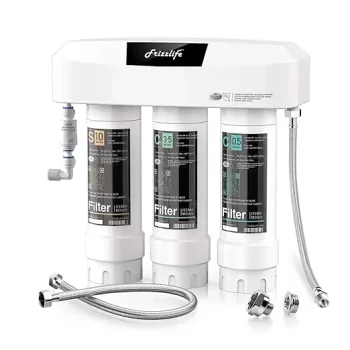Tap water is an essential source of drinking water for our health. But did you know it can be contaminated by harmful chemicals like PFAS/PFOS, which pose a threat to our health?
Luckily, under-sink filters are capable to reduce dramatically the amount of PFAS in your tap water.
How Do Under-Sink Filters Work?
These filters are easy to install under your kitchen sink and fit most faucets. They use various technologies to remove contaminants from the water, including PFAS/PFOS:
- Activated Carbon: This porous material absorbs contaminants from the water, effectively removing PFAS/PFOS.
- Membrane Filtration: This method uses a fine membrane to block particles and contaminants, making it effective for eliminating small PFAS/PFOS.
- Ion Exchange Resin: This technology swaps ions in the water with other ions, effectively removing charged PFAS/PFOS.

Benefits of Under-Sink Filters
- Efficiency: These filters are highly effective at removing PFAS/PFOS from tap water.
- Ease of Use: They are simple to install and use.
- Affordable: Under-sink filters offer a budget-friendly solution to reducing PFAS/PFOS exposure.
Choosing Your Under-Sink Filter
When selecting an under-sink filter, consider:
-
- Filtration Technology: Ensure the filter uses technology proven to remove PFAS/PFOS. Look for filters certified by independent entities for guaranteed effectiveness. Certified undersink filters will be capable to reduce PFAS presence by a minimum of 95% and some may even reach 99+% !
- Filtration Capacity: Choose a filter that matches your water consumption needs.
- Cost: Compare prices of different under-sink filter models. Typical undersink filters purchasing price will start around 50$. Do not neglect though the cost of the cartridges that you will need to replace regularly. Keep in mind that some manufacturers will price the system low, but will charge you a fortune for the cartridges…
Certification Standards
Several international and national standards exist for PFAS filters, including:
-
- NSF/ANSI 53: Certifies that the filter reduces public health contaminants like lead, chlorine, and cysts, ensuring potable water.
- NSF/ANSI 58: Leverages the NSF53 criteria, but applies particularly to reverse osmosis systems and membranes.
- DWD (Drinking Water Directive): This European standard is similar to NSF/ANSI 53, certifying that the filter is compatible with drinking water.
Why Choose a Certified Filter?
Opting for a certified filter offers several benefits:
-
- Guaranteed Effectiveness: Certified filters are tested and proven to reduce PFAS/PFOS in tap water.
- Reliability: Certifications are issued by independent and recognized organizations, ensuring reliable tests and results.
- Safety: Certified filters ensure no harmful substances are released into the water.
In conclusion, under-sink filters are an effective and affordable way to reduce PFAS/PFOS exposure in tap water. Choose certified filters for optimal protection. By investing in a quality filter, you can protect your family and enjoy healthier drinking water.
Our Selection of Under-Sink Filters
It’s highly recommended to prioritize filters with independently verified PFAS filtration capabilities, certified to NSF 53 or NSF 58 standards, like the ones listed below:
 |
 |
 |
 |
 |
|
| Model | SK99 NEW | 15UA | MK99 | WS-US-001 basic | Freshpoint Easy Flow |
| Brand | FRIZZLIFE | WATERDROP | FRIZZLIFE | WINGSOL | PENTAIR |
| Dimensions | 15″L 14″W 5″H |
3.6″L 3.6″H 16.7″H |
14.7″L 7″W 6.77″H |
5″L 5″W 13″H |
5″L 5″W 15″H |
| Certification | NSF/ANSI 42 NSF/ANSI 53 |
NSF/ANSI 42 | NSF/ANSI 42 NSF/ANSI 53 |
NSF/ANSI 42 NSF/ANSI 53 |
NSF/ANSI 42 NSF/ANSI 53 |
| Price range | 135,99$ | 64,79$ | 69,99$ | 39,99$ | 139,00$ |
| Where to Buy? | Buy on Amazon | Buy on Amazon | Buy on Amazon | Buy on Amazon | Buy on Amazon |
Important: The listed flow rates are often calculated at pressures higher than your tap. Be conservative and use these values as a comparison tool. For reference, a flow rate of 0.5gpm equates to filling a small glass of water in 10 seconds.
Equally important: The filters listed above were chosen for their demonstrated ability to reduce PFAS in drinking water. While the technologies used are often similar (ion exchange resin, activated carbon, etc.), the performance of these filters can vary significantly – notably when it comes to the lifespan of the cartridges.
Keep in mind as well that, if these under sink filters seem pricy to you, you can still start with an NSF53 certified pitcher, which represents a cheap alternative to PFAS reduction.
Feel free to share this article with friends and family to raise awareness about the dangers of PFAS/PFOS and the solutions available to protect against them.
- Sorptive removal of short-chain perfluoroalkyl substances (PFAS) during drinking water treatment using activated carbon and anion exchanger, Environmental Sciences Europe
- PFAS removal by ion exchange resins: A review, Science Direct
- Does Reverse Osmosis Treat PFAS?, VEOLIA
- Multi-Industry Per- and Polyfluoroalkyl Substances (PFAS) Study – 2021 Preliminary Report, EPA
- Treatment of drinking water to remove PFAS (Signal), European Evironment Agency



